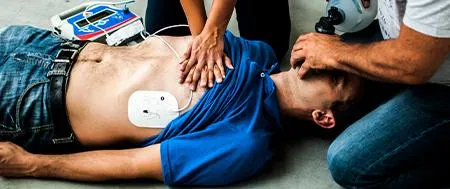Rutland First Aid Training
BLOG

What should be in my first aid kit?
This is one of the top questions we get during our first aid courses! When we ask participants what they think should go in a first aid kit, answers range widely—bandages, plasters, safety pins, eyewash, cleansing wipes, and more. But while it's easy to purchase a pre-made first aid kit, it’s essential to ensure that the contents truly match your needs and provide good value.
So, what exactly should go in your first aid kit?
Start with a First Aid Risk Assessment
To decide on your kit’s contents, it helps to do a first aid risk assessment that highlights the types of injuries you might encounter. For example, a workspace with risks of severe cuts or amputations will need more than basic plasters and wipes. In an office, however, tourniquets and haemostatic dressings might be unnecessary!
A first aid risk assessment lets you outline potential hazards, assess the likelihood of injury, and understand what is "adequate and appropriate" for your environment. From there, you can start building your kit with items that meet these specific needs.
Basic Items for Most First Aid Kits
Here are some essentials for any well-stocked first aid kit:
Guidance Leaflet: Basic first aid instructions can be invaluable in an emergency.
Safety or Tough-Cut Scissors: To cut through clothing or bandages quickly.
Triangular Bandages: Often underappreciated but highly versatile.
Vinyl Gloves: Essential to avoid latex allergies in case your patient is sensitive.
Face Shields: For safe CPR administration. (Handy Rutland First Aid keyrings come with face shields and vinyl gloves for on-the-go protection!)
Clean-Up Kit: It’s crucial to safely clean up blood or bodily fluids after an incident to prevent cross-infection. You can buy a pre-made clean-up kit or assemble one with:
Yellow hazardous waste bags
Extra vinyl gloves
Disposable gauntlets and aprons
Clean-up cloths and absorbent granules
Plastic scrapers for safe disposal of granules
Disinfectant for thorough sanitisation
Additional Items Based on Risk Assessment
After covering the basics, add any items identified in your risk assessment. Depending on your workplace, you might need:
Lint-free dressings
A variety of bandages, with and without dressings
Sam Splints for immobilising fractures
Considerations for a First Aid Kit That Works for Your Environment
Assess these factors to ensure your first aid arrangements meet your needs:
Type of Work & Workplace Hazards: Match contents to the risks specific to your activities.
Size of Team & Shift Patterns: Larger or varied teams may require more supplies or multiple kits.
Accident History: Past incidents can help pinpoint specific needs.
Proximity to Medical Services: In remote areas, additional supplies may be essential.
Other factors to keep in mind are remote workers, first aid for public visitors, and mental health support. For non-emergency items like plasters, consider making these freely accessible outside of the first aid kit to avoid depleting it unnecessarily.
Plasters
Things to think about though, should plasters really be in a first aid kit? Surely they are better in an area where they are freely accessible to all and do not require a first aid person to administer them, plus it means that not everyone is taking items out of the first aid kit and you find that the items you require are not there when you need them most!
HSE Guidance on First Aid Kits
The Health and Safety Executive (HSE) does not directly regulate the first aid industry, nor does it mandate what should be in your first aid kit. There is no compulsory list of items, as the contents should be determined by the specific risks associated with your workplace. This means that each kit should be tailored based on a thorough first aid needs assessment.
Guidance for Low-Hazard Environments
For workplaces with low-hazard activities, the HSE provides a suggested minimum stock of items:
Guidance Leaflet: General advice on first aid (e.g., the HSE leaflet Basic Advice on First Aid at Work).
Plasters: 20 individually wrapped, sterile plasters in assorted sizes, suitable for the type of work (hypoallergenic plasters can be provided if necessary).
Sterile Eye Pads: Two eye pads to handle minor eye injuries.
Triangular Bandages: Two, preferably sterile, triangular bandages.
Safety Pins: Six pins for securing bandages and other uses.
Large Wound Dressings: Two sterile, individually wrapped unmedicated wound dressings.
Medium Wound Dressings: Six sterile, individually wrapped unmedicated wound dressings.
Disposable Gloves: At least three pairs (HSE has guidance on selecting latex gloves if required; see HSE’s latex glove guidance).
These recommendations serve as a guideline for low-risk environments, but the exact contents should still be guided by the needs identified in your assessment.
Additional Standards - British Standard BS 8599
For further clarity, the British Standard BS 8599 outlines recommended contents for workplace first aid kits. This standard provides a useful framework, but it is not compulsory. You may choose a BS 8599-compliant kit or an alternative that better reflects your specific first aid needs.
Ultimately, the HSE emphasizes that the decision on what to include in your kit rests with the findings of your first aid needs assessment, ensuring that your provisions are relevant and suitable for your workplace.
Regular Checks and Prohibitions
Remember, first aid kits require regular inspections to replace expired items. Avoid including medications like paracetamol, as only trained medical personnel should dispense drugs. The exception is aspirin, but only trained first aiders should administer it.
If you’re interested in building up your first aid skills—whether it’s CPR, AED, Emergency First Aid at Work, or First Aid for Children—check out our course offerings or contact us. We’d be happy to advise on the best fit for your needs!
Hear what our first aid students have to say...
TESTIMONIALS


A really good training course, very professionally presented by Tracy. I’ve been on lots of training courses over the years and too often they can be soporific! Tracy is one of those rare training professionals who can deliver training and keep a person interested all day! Great course. Highly recommended!

Alan Eager
Google Review


Rutland first aid are professional yet kept the courses fun and interactive and use some very interesting props. As a driving instructor I wanted to be able to deal with any issues with my students but also any issues I may come across on the roads. Highly recommended.

James Dames
Google Review


Couldn't recommend Tracy and her team enough for a first aid course. Having to renew it every 3 years used to send me to sleep. Not with these guys! Professional, up to date and with lots of toys to play with, without the death by powerpoint.

Mike Gould
Google Review

Here at Rutland First Aid Training we strive to provide high quality, personalised, fun and informative first aid courses.
Our courses are recognised by HSE, Ofsted and follow ILCOR guidelines.
Short Cuts
Find what you are looking for:
Dental CPD Courses
Get In Touch
If you have any questions or would like to discuss your requirements in further detail, our team are always happy to assist you.
Unit 2B Station Approach, Oakham, Rutland LE15 6QW
@ 2025 Copyright Rutland First Aid Training. All rights reserved.
Rutland First Aid Training is a trading name of Dive Rutland Limited. Company No: 9433835.




